TRADES LANDSCAPE





The FSA 135 R is the latest brushcutter in our battery-powered line-up that can be used in noise-sensitive situations. It is a lightweight, powerful and efficient choice for landscapers, municipal workers and those that have large yards to upkeep. The AP battery can be inserted directly into the powerhead, as opposed to using an adapter system. The ergonomic loop handle makes it comfortable to operate and easy-tomanoeuvre, while also providing a three-step speed adjustment with LED light. Built with a metal mesh air filter, it delivers a longer service life and provides optimum motor cooling. Also, a wide selection of cutting attachments can be used on the FSA 135 R to suit the job at hand.
NOTE: Bike handle version also available.
SPECIFICATIONS
Battery Power. Made by STIHL.


PRO-FLEET COMMERCIAL LANDSCAPE PROGRAM
STIHL’s Pro-Fleet Commercial Landscape Program is designed to provide commercial landscapers a volume discount on purchases of five or more landscaping power tools. Receive additional savings on STIHL battery products until June 30, 2023. Visit your STIHL Dealer today to learn about our power, performance and durability difference.
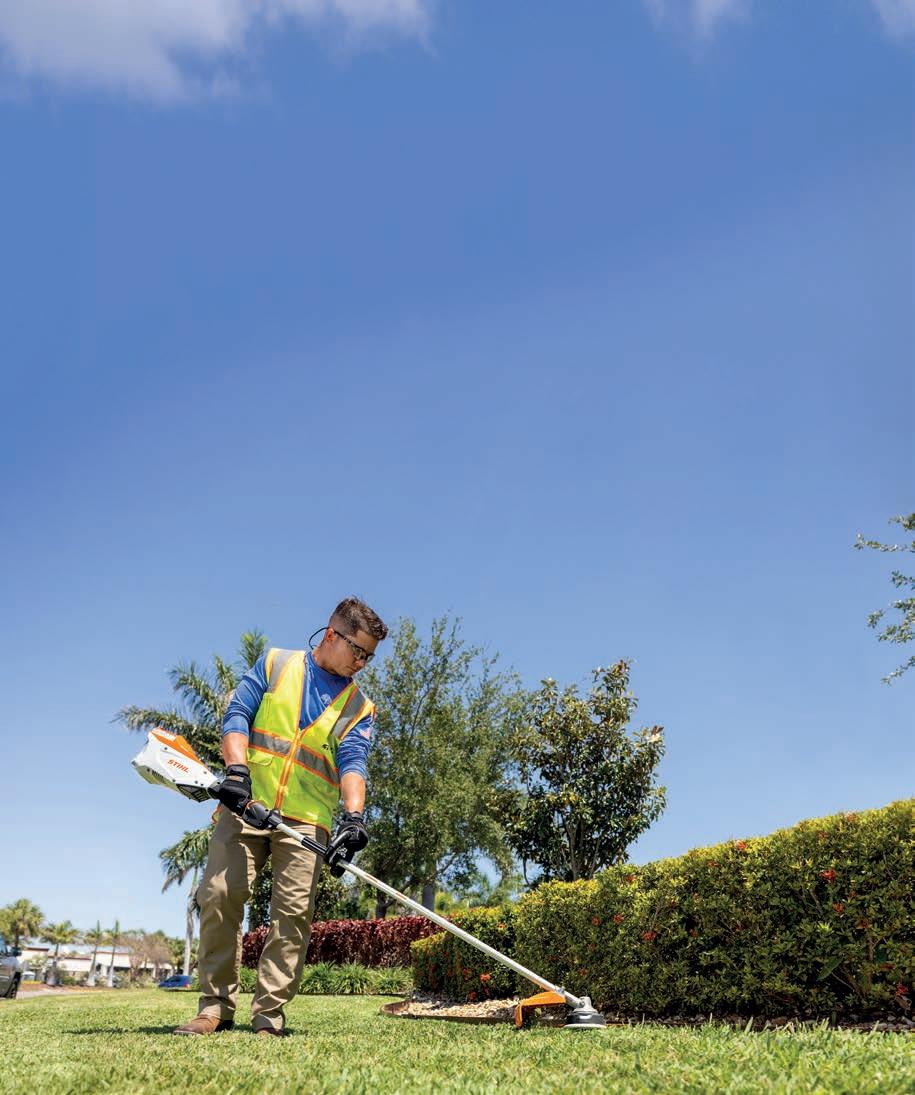
Scan code for more product information or visit www.stihl.ca

8 ARE LANDSCAPE DESIGNERS
WHO DESIGN BY HAND A DYING BREED?

Tony Lombardi, Paul Brydges and Randy Tumber explain why they’re not ready to put their pencils down.
BY SCOTT BARBER14 MAGIC AND MYSTERY OF DRY STONE

The enchanting hobbit house at Dibbits Landscape Supply takes you back in time.
BY KARINA SINCLAIR20 SOIL MANAGEMENT AND SAFEGUARDING TREE HEALTH

Protecting the soil ensures trees live long, healthy lives, and prevents unnecessary and premature tree removal costs.
BY KYLE MCLOUGHLIN26 SHEEP GRAZING FOR TREE NURSERIES
NVK Nurseries experiments with sheep grazing to improve soil health and ecosystem services.
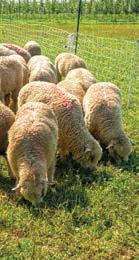 BY GILLES LAPOINTE
BY GILLES LAPOINTE
30 PLANTS ARE THE LUNGS OF OUR CITIES
Green Cities Foundation Chair Alan White champions the power of plants to sequester carbon and clean and cool the air.
BY SCOTT BARBER34 PHOTOGRAPHER SPOTLIGHT
Brett Hitchin’s work focuses on portfolio imagery for distinguished architects, landscape designers, and engineering firms, helping to communicate the value of their work through multi-disciplinary visuals.
BY SCOTT BARBERThis elegant English Bay, B.C. residence features an infinity pool with bold lines that follow the bend of the coastline.

Photo: Brett Hitchins, Brett Ryan Studios Landscape architecture: Paul Sangha Creative

EDITOR & PUBLISHER
Scott Barber
CREATIVE DIRECTOR
Mike Wasilewski
ASSISTANT EDITOR
Robert Ellidge
MULTIMEDIA JOURNALIST
Karina Sinclair
ACCOUNT MANAGER
Greg Sumsion
ACCOUNT MANAGER
Liz Lant
COMMUNICATIONS COORDINATOR
Angela Lindsay
DIGITAL MARKETING SPECIALIST
Charlotte Guena
ACCOUNTANT
Joe Sabatino
STAFF CONTACT INFO AT LANDSCAPETRADES.COM/CONTACT
ADVISORY COMMITTEE
Gerald Boot CLM, Lindsay Drake Nightingale, Jeremy Feenstra, Mark Fisher, Hank Gelderman CHT, Bob Tubby CLM, Nick Winkelmolen
Landscape Trades is published by Landscape Ontario Horticultural Trades Association 7856 Fifth Line South, Milton, ON L9T 2X8 comments@landscapetrades.com www.landscapetrades.com
Landscape Trades is published six times a year: February, March, May, August, October and December.
SUBSCRIPTION RATES: One year – $46.90 | Two years – $84.74 | Three years – $118.64 HST included. U.S. and international please add $20.00 per year for postage and handling.
Subscribe at www.landscapetrades.com
40 INTERNET OF NATURE
Meet @bowiethebirch — one of the world’s first urban tweeting trees, dealing with uniquely urban issues like soil pollution, compaction, the heat island effect, urinating dogs, and more.
BY DR. NADINA GALLE44 GROWING YOUR BUSINESS
Sell your process — you have to show clients you are the right choice. More people are willing to pay for the design than you think.
 BY GEORGE URVARI
BY GEORGE URVARI
48 LEGAL MATTERS
Managing the exclusion and expiry of claims through contract documents in Canada.
 BY ROB KENNALLEY
BY ROB KENNALLEY


Greenhorizons Sod Farms is one of the largest nursery grown sod producers in Ontario and has earned a reputation of having a commitment to quality, service and innovation. From large scale municipal projects and world class sports fields, to landscape job sites and residential projects; supplying top-quality sod to ensure your project is a success, is our #1 priority. These are just some of the reasons that Greenhorizons Sod Farms is the Professionals Choice.

The Snow & Ice Symposium helps you forge professional relationships, expand your knowledge and connect with innovative suppliers

Join us for snow-focused education, 150+ exhibit booths, liquids workshop, facility tour, and networking.
REGISTER TODAY!
Scan QR code or visit show.sima.org

EDUCATION
2 keynotes
Liquids workshop
Facility tour
5 workshops
15+ concurrent sessions
JUNE 13-16,
Welcome reception
Snack & Chat
NEW! Breakfast Jamboree
Role-focused roundtables
SIMA After Hours
Ride the rails closing event

8+ dedicated trade show hours
150+ exhibitors across multiple product categories
NEW! Visit our Sideshow tents for mini-education sessions


Landscape designers and architects have used Computer-Aided Design (CAD) software since the 1970s, and the technology has come a long way over the last 50 years. With software improving every year, empowering professionals to create sophisticated designs with precision and efficiency, is there still a place for the drafting table in a modern design studio?

Tony Lombardi isn’t ready to put down his pencil just yet. As the owner and principal of Dr. Landscape, a boutique landscape design, installation and landscape and garden management firm based in Toronto, Ont., Lombardi uses a combination of CAD software and hand drawing. However, it’s clear where his passion lies.
“Being resistant to change and new technologies isn’t usually good,” Lombardi said. “I think it’s important to introduce new tools and ensure you have as much as you can use in your toolbox. I also think there’s an incomparable value in being able to draw by hand. You can’t plant flowers with a machine, right? You’ve got to do it with your hands. You’ve got to touch the earth. You’ve got to know where plants will grow and thrive and then use your hand shovel and put that plant in the ground, carefully and with love. There are no robots that do that, maybe one day, but it’d be a sad day if that happened. The beauty of nature is being able to interact with it on a very personal level. If you take that thought and incorporate it into design and drawing, I think the true enjoyment of drawing by hand is just that interaction. That personal touch, that pen to paper, the connection.”
While his creative spark comes at the drafting table, Lombardi knows other professionals have a similar connection to design software.
“I think the most important things for designers are their passion and creativity,” Lombardi said. “For me, that passion and creativity comes out at the drafting table. I’m sure somebody who designs with a computer could be equally passionate and creative. It’s almost like a different wavelength, but the purpose and the drive are still the same. I think it’s how you’re wired, but it’s that interaction to come up with an idea from your brain, put it on paper or the screen and then make it a reality.”
Paul Brydges shares the belief that there is something intangible — yet invaluable, about drawing designs by hand.
“When I’m drawing on my board, I put it on a 36- by 48-inch sheet,” said Brydges, the founder and principal landscape architect of the Guelph, Ont.-based Brydges Landscape Architecture. “I’m looking at the entire property as a holistic element. So the front yard relates to the backyard, which relates to the side yard, and I can see the whole thing I’m working on at once… If I want to make a change or I get stuck on something, I can just move to the other side of the property. I don’t have to change screens. I don’t have to change my focus or my view. It’s almost like you’re walking through the space. It keeps you working on a human scale. And that’s what we’re designing for. So it keeps us working very clearly at the proper human scale to visually and mentally travel through the space.”
That perspective is also essential to Lombardi. “Seeing the whole picture is what I enjoy more about drawing by hand,” Lombardi said. “As opposed to when you’re on a computer, you either have to have a massive screen to do that, or to focus on a small area and zoom it out or in.”
He added, “I never liked looking at a screen. But, of course, I work on a computer all the time, doing all my email and quotes and everything else. But doing my drawings, I hate it on a computer. And even when quoting a job, I’ll still get drawings printed on a full sheet of paper so I can see the whole thing, absorb it, and understand the whole picture. That’s just how my brain works.”
Randy Tumber, founder of the Orangeville, Ont.-based landscape design firm Tumber & Associates, began designing

landscapes in the 1970s before CAD software was widely used. As his company grew, Tumber began hiring talented artists to bring his designs to life. His preference was always for hand-drawn work, though he says whether a design is created with a pencil or a computer, the key is that it evokes an emotional response.
“I always use the illustration of the first time I ever saw the Rocky Mountains, or the first time I saw a beautiful pink sand beach with palm trees and beautiful flowers and the sights and sounds and smells of the ocean,” Tumber explained. “You don’t look at that and say, ‘Ah, that’s pretty nice. I wonder what’s on TV?’ You look at that and say, ‘Wow! That’s awesome!’ It blows your mind. And it goes to your heart. It goes beyond the visual. It evokes an emotional response. That is my goal on every single project.”
Tumber believes hand-drawn designs are more effective at delivering that emotional response.
“The pencil is something that helps you cut to the heart of the matter and express yourself,” he said. “With a computer screen, I have not seen it accomplished in the same way yet.”
To him, hand-drawn designs make an impact that is difficult to replicate.
“Hand-rendered drawings, in my mind, are our work of art,” he said. “I would set them up on an easel with a vellum over the top and have the clients sit there, and I’d say, ‘Okay, ready for this?’ Then I would pull it back for the reveal, and I’d hear oohs and ahhs; spectacular stuff. That part of it was great.”
Tumber added, “The term ‘blown away’ was used constantly. But again, that was also based on the content of the designs. My heart was in each and every one.”





On the other hand, Lombardi acknowledges that not everyone can hand draw well or quickly. “Like anything, practice enables an individual to be efficient with any skill. CAD drawings certainly have an efficiency and benefit to businesses, but there is an invaluable relationship in the process of creativity which connects the human brain to the human hand to a physical creation.
“Time is a big constraint sometimes, which is why my firm does both (hand-drawn and computer designs),” Lombardi said. “When time is an issue, I’ll either subcontract the work or get one of the people in the office to do CAD design. They’ll produce a base plan, and then I’ll develop the idea. So the base plan is the first layer of things, the existing site, amenities and conditions, and then I’ll do the sketch on top of that. I would love to be a part of the whole process, but you can’t do everything when you own a business.”
Other times, Lombardi will do rough sketches on the spot with clients right at their dining room table.
“There’s a little bit of pressure,” he explained. “You’re on the spot, but when an idea pops out — it’s like a eureka moment, you know? It’s exciting. You come up with an idea and have the ability to share it for the client, right there in front of them. Clients love it and so do I.”
Brydges also enjoys that experience.
“I find clients really appreciate it when I’m able to grab a pencil to draw something for them,” Brydges said. “There’s something natural about being able to sketch out the ideas we’re talking about. I’ll say, ‘you want to see that detail?’ Or, ‘we can do this for that pergola, or here are those shrubs we’re talking about.’ They
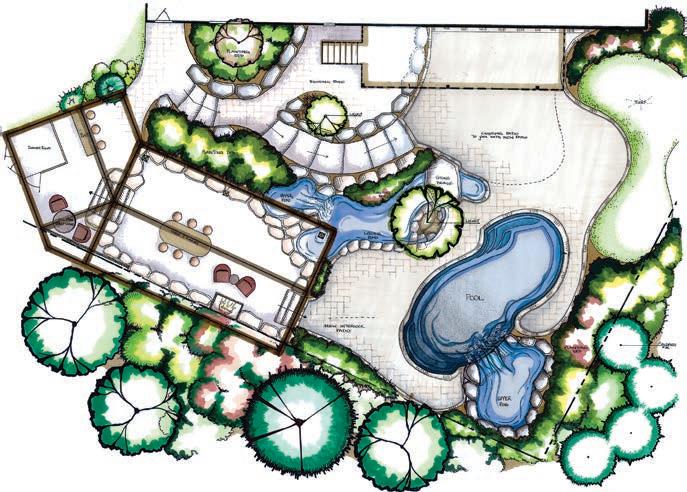
get fascinated that I can articulate it without having to say, ‘Just a minute, let me fire up my computer to find a picture on Pinterest.’ I find it’s simpler to sketch it out.”
Are there ways to recapture those moments with a tablet? Perhaps. But there’s just something tactile and tangible to the hand sketch that Lombardi, Brydges and Tumber don’t want to give up. All three emphasized the fact they respect the creativity and skill of their colleagues who thrive with software. But they also hope the craft of hand-drawn design continues for future generations.
“It does make me sad to think it’s a dying art,” Lombardi said. “It’s not to insult anybody who designs on a computer, but I think there is a place for having the ability to draw by hand because there is just something to, you know, pen to paper — that connection. It’s difficult to explain.”
Lombardi added, “I think anybody who puts their passion into a design, either by hand or on a computer, at the end of it, there’s that joy in standing back and looking at what you’ve accomplished. Then, being able to present it and have the client love it. There’s that satisfaction. Anytime you finish a presentation and you walk out of the clients’ home, there’s that endorphin rush. The rush of adrenaline, and you’re so pleased and you’re so happy. It’s the drug of creativity, I guess. What is that expression? Do what you love and you’ll never work a day in your life.” LT



n a quest for armour stone and river rock, the intrepid landscaper needs only to journey to Dibbits Landscape Supply in Trenton, Ont. There, a vast array presents itself, but first, the adventurer must make it past the ancient mystical monument known only to those with secret knowledge: the hobbit house.
Well, okay, it’s not exactly a secret, and it’s not ancient either. But it does have an aura of mystery. And if you’re lucky enough to wander toward Prince Edward County, you’ll encounter an utterly charming dry stone home with a round, cheery yellow front door nestled between a pond and a waterfall.
Even though the structure has only been in place since 2019, the dry stone dome evokes a sense of time travel. Looking closely, you may find fossils from another epoch. After all, the limestone bedrock of Southern Ontario was once under a tropical sea some 500 million years ago (give or take a few million).
This monument marks the entrance to a decidedly modern enterprise. Skid steers and forklifts kick up clouds of dust as they shuffle loads of mulch, gravel, and stone pavers into clients’ trailers. Once upon a time, the long-running family business solely focused on excavation services but has since pivoted to landscape supply.
You might wonder why a landscape supply yard would host such an unusual structure; you wouldn’t be the first to ponder. “Many people that are mentors to me would often ask, ‘why would you spend so much resources on building a display item that doesn’t show a return on your investment?’” said Joe Dibbits, owner and president of Dibbits Landscape Supply. “But the big part of what
we do here at Dibbits is we want to not necessarily just inspire people, but we want to make Dibbits a destination. And we’d like to see people come to see the hobbit house. They don’t necessarily have to come to buy products.”
Even in the early stages of planning a destination-worthy feature, Dibbits knew he wanted some kind of dry stone structure. He invited renowned stone artist John Shaw-Rimmington to take a look at the site. Together, they considered different possibilities, but when Shaw-Rimmington asked him what he really wanted, Dibbits drew on inspiration from literature.

“I’ve always enjoyed the Hobbit series by Tolkien, and I just mentioned it would be kind of cool to have built our own hobbit house.” Dibbits recalled Shaw-Rimmington enthusiastically replied: “I’ve never built a house. Let’s do it.” And so the saga began.
“We thought it would be nice to give an opportunity for others to be involved,” Dibbits said. “There’s a lot of people in the landscape industry and even those outside it have an interest in stone. So we put it out there to invite people and it was open to anyone.”
The experience took the project from foundation to copestone completion. ShawRimmington said: “We built it without any machinery. It was all done as a workshop with, I think, four men and four women over
two weekends. And we were happy, happy, happy people.”
After tucking himself quite nimbly into the curved entrance of the house, self-proclaimed “creative stone guy” Shaw-Rimmington explained this particular structure was made in reference to a movement that has encompassed magic, enchantment, and many of the things that stone inspires in people. “I think this structure is really something that is almost wanting to be built out of stone. It’s appealing to your imagination. It’s appealing to a sense of history,” Shaw-Rimmington said.
And now, though created in a relatively quick timeframe, the stone house looks as though it’s been in place since time immemorial. “That is one of the main qualities of stone,” Shaw-Rimmington said, “if you’re careful and you do it right, it will look like it’s been there forever.”
As modern trends lean toward precision cuts and high polish, the rawness of this structure is what makes it so intriguing. “I like to use stone to draw people out of their normal day-to-day world. I think stone is that raw ingredient that, if used properly, captures an element of other,” Shaw-Rimmington mused. The former conservation stonemason explained there’s an unspoken rule that if you don’t have to shape it, don’t. “That’s really one of the key things — it’s accepting that nature provides for you. Look at your
stones you have and accept them for what they are rather than want to change them first,” he said. “I encourage people who are working with me to refrain from bringing out the saws and the hammers and things. We are hung up as a culture on perfection. I’ve discovered that there’s a lot of things you can do that are within that range of ‘Yeah, that’s okay.’”
When asked how he knows where to place each stone, Shaw-Rimmington chuckled at what he called a loaded question. “There’s two different types of knowledge,” he said. “There’s our technical cerebral knowledge and there’s our body knowledge. And stone loves to work with both. I’ve discovered that sometimes my hands will pick up a stone and my brain will try to convince me by saying ‘that’ll never fit there’ and my hands say ‘we’ll just try it.’ Then you just come to the wall with a stone as a sort of gift and you say, ‘Is it here? Does it work?’ And more than often it does.”
He suggests that synchronicity comes when you allow yourself to be open. “The stone is trying to teach you something. There are places in life where there are these tiny synchronicities where you go, ‘Hmm, is there something else going on here?’ And I think if you enjoy that feeling and want to experience it more, stone is the best place to start because the synchronicities seem to happen more,” Shaw-Rimmington said. “It’s a very important, life-changing thing.”
If you have the will to take a stand in tough mowing conditions, the new hydraulic-drive WB700 walk-behind mower gives you winning precision for the battle.
BOBCAT OF HAMILTON, LTD.
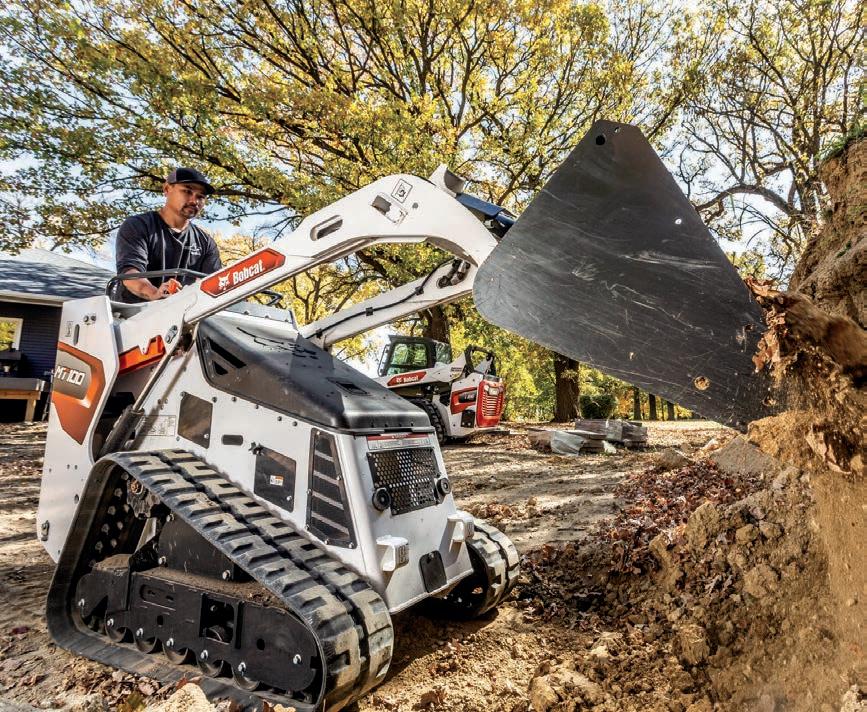

Stoney Creek 905-643-3177
www.BobcatofHamilton.com
BOBCAT OF BARRIE
Barrie 705-726-2228
www.OakenEquipment.ca
BOBCAT OF BRANTFORD, INC.
Brantford 519-752-7900
www.BobcatofBrantford.com
BOBCAT OF DURHAM EAST, LTD.
Courtice 905-404-9990
www.BobcatofDurhamEast.com
BOBCAT OF GREY BRUCE
Owen Sound 519-372-9100
www.BobcatofTC.com
BOBCAT OF HURON
Walton 877-887-6365
BOBCAT OF LONDON, LTD.
London 519-455-4900
www.BobcatofLondon.ca
BOBCAT OF MUSKOKA
Muskoka 249-390-7000
www.OakenEquipment.ca
BOBCAT OF PARRY SOUND
Nobel 705-342-1717

www.BobcatofParrySound.com
BOBCAT OF PETERBOROUGH
Peterborough 705-748-9199
www.BobcatofPeterborough.com
BOBCAT OF SAULT STE. MARIE
Sault Ste. Marie 705-949-7379
www.Bobcat-ssm.com
BOBCAT OF STRATFORD
Stratford 519-393-6040
www.BobcatofStratford.ca
BOBCAT OF THE TRI-CITIES, LTD.
Kitchener 519-579-9100
www.BobcatofTC.com
BOBCAT OF WINDSOR
Windsor 844-807-0120
www.OakenEquipment.ca
BOBCAT OF TORONTO
Brampton 416-679-4172
Scarborough 416-679-4171
www.OakenEquipment.ca
Equipment World Inc.
Thunder bay 807-623-9561
www.Bobcat-tbay.com
KUCERA GROUP CHATHAM
Chatham 519-351-4300
JOHN'S EQUIPMENT
SALES & SERVICE, LTD.
Frankford 613-398-6522
www.JohnsEquipmentSales.com
That open-minded approach works for Dibbits, too, who sees his role in the landscape industry as helping others build, stone by stone, toward their own success stories. “It’s not that we just want their business. We want to be a part of what they do. We hope that we can maybe mentor them in some way, make their business better. And I think there’s unlimited potential in this industry,” said Dibbits. His goal is to “walk the journey with as many people as possible.”


His advice for his peers is to “Look at it as a shared journey. So whether that’s, you know, with other landscape supplier dealerships or contractors or customers, we’re all in it together.”

The dome stone structure, by its very construction, is a reflection of how a community — such as those in the landscape trades — are stronger together. When properly aligned, a selection of unique components (even with flaws and fossils) can become something resilient enough to withstand the elements. It can be useful, beautiful, and supportive of the realm around it. And while it endures, it also evolves.
Once stacked and secured, the stones were ready for the next chapter. The top of the dome was covered with geotextile fabric and grading was added to give it lateral strength. Then came a deep layer of organic topsoil. The original plan was to finish it off with grass. “But then, you know, a true hobbit house doesn’t have sod growing on it that’s manicured,” Dibbits said. “So we wanted to complement it with natural plantings. We wanted to hire somebody that had a bit of expertise in putting together a good blend of plants.”

Dibbits sent a raven with a parchment invitation (or perhaps it was an email) to a landscape designer known for her naturalized meadows, Karina Lapierre from Lavish Gardens in nearby Stirling, Ont. “We asked Karina to be involved in the design and layout for the plantings,” Dibbits explained. “And we’re very pleased that, after virtually one growing season, it is starting to come into its own. We’re hoping to see more plantings sort of overhang the face of it to give it more of a hobbit feel.”
The mix of Ontario native plants added soft colour and movement. Bees and butterflies
move from blossom to blossom in the afternoon sun. Dibbits said the garden has attracted a variety of birds, the odd rabbit, and he’s noticed lots of chipmunks making their homes amongst the rocks and flowers. Lapierre also designed and installed the towering waterfalls that’s just to the right of the dry stone house, blending the two extraordinary features together in harmony.

Despite the bustle of a busy supply yard, Dibbits finds peace in this timeless space. “When the sun comes up, it sort of hits the face of it right away. And it’s a warm time in the morning. It sort of gives you the sense that great things are going to happen.”
Shaw-Rimmington agreed the scene inspires possibility. “It takes a lot of imagination, but it’s still here as a reminder that there are places on the planet where you can find soul, solace and calm. I like to think there’s some sort of mystical power or potential here.”
In time, this humble stone structure will honour the legacy of its builders — a testament of an ancient past as well as a hereafter grounded in strength and support. It may inspire a new generation of landscapers to put their hands to the bedrock, sense creativity, and invoke the collaboration of fellow adventurers. “I am very excited for the future,” Dibbits concluded. “It’s going to be a great journey.” LT
 BY KYLE MCLOUGHLIN
BY KYLE MCLOUGHLIN

Ahealthy, mature tree survives and flourishes best when its soil remains undisturbed. Mature trees are a vital component to quality landscapes, so it makes sense to take measures to avoid and mitigate the potentially harmful impacts on trees through construction, plant bed installation, and hard landscaping. (Hard landscaping will almost always disturb soil, potentially adversely affecting the health and longevity of a tree.) While it is true that trees can withstand non-optimum conditions and situations, if the project goals include healthy, good looking trees, it is critical to minimize soil disturbance. This means good soil structure, good soil chemistry, and good soil protection. Protecting the soil ensures trees live long and stay healthy, with less risk of tree death or failure, and prevents unnecessary tree removal costs.
If we want to avoid damaging the soil, it helps to understand the fundamentals of how soil works and how to remediate it. Healthy soil is porous and allows for oxygen and water to move within the soil, making it available to trees and plants. Compacted soil has smaller pores for oxygen and water. A general rule of thumb for healthy soil suggests it is composed of 50 per cent pore space (holding 25 per cent water and 25 per cent air) and 50 per cent solids — composed mostly of mineral particles with about two to five per cent organic matter. This ideal mix of healthy soil provides easy penetration for an everexpanding root system as the tree grows. This deep root penetration helps to anchor the tree — physically supporting the tree and keeping it upright. Pore spaces contain air, allowing tree roots to absorb the oxygen required to maintain respiration — the process by which all living organisms convert food into the energy that fuels living and growth. The water retained within air spaces is equally vital. Maintaining these soil services is a vital key to tree longevity.
Fertility is based on a healthy ecosystem. The role of maintaining a healthy, bio-active soil ecosystem cannot be overstated. It cycles nutrients and is meant to prevent runoff. The soil food web exists in a balance that (in natural forests) is vibrantly alive — ultimately supporting healthy, vigorous trees. These eco-processes satisfy all the requirements for a healthy soil, ensuring ease of root penetration, oxygen, water and nutrients are continuously available to trees.
Urban trees exist in a much different
environment where such a vibrant soil ecosystem is not present and suppressors to health are legion. Trees are beset by limited soil for root growth, pollution and the effects of human use and construction. Where the ideal forest environment is not possible, maximizing good conditions and minimizing the bad can markedly improve the chances for urban trees to survive in a healthy state for longer than would otherwise be possible. Any measures that are taken to reduce damage and encourage health will make a difference.
Compaction will limit root penetration and thereby limit root growth, preventing the uptake of water and nutrients. In addition, as compaction reduces pore spaces it lowers the amount of oxygen and water available to the tree long term. On top of this, compaction also reduces drainage which can cause oversaturated, oxygen-poor soil — conditions that encourage disease and root deterioration. Deadly fungal diseases
12x24 Stone NEW!


Individually Packaged Available in all 4 Molina® colours
Great for rooftop applications!
Molina® slab is a durable, super-smooth EliteFinishTM face-mix product, with the added benefit of ColorBoldTM to help maintain vibrant colours and stain resistance. Perfect for patios and pool decks, the smooth surface, clean edges and reduced joint spacing of Molina® give your exterior floors a sumptuous and refined look. For more info visit OaksPavers.com
24x24 Stone NEW!
Individually Packaged Available in all 4 Molina® colours
like Armillaria root rot are a common result of compaction and moisture damage. Preventing soil compaction that may occur during hard landscaping will significantly help maintain tree health and lifespan. Adding chemicals does not help compacted soil. Organic matter is the primary source of the nutrients that feed trees.
Adding fill, even where it is quality top soil, can also be damaging when it buries a tree’s stem (trunk) and deprives the roots of oxygen and increases moisture retention, depending of course on the depth of soil added. The loss of oxygen combined with the increase in moisture can actually lead to root or stem decay. Mulch can do this in much the same way. Eventually, fill will lead to root death, trunk decay, and decline.
Some measures promoted as remedial are not helpful, and in fact, may be harmful. A small layer of mulch (one to two inches) can help retain moisture, keep exposed soil cool and help prevent string trimmer damage on tree trunks. Too much mulch can result in excess moisture retention around the tree base.

Bark likes to stay dry. Too much moisture can encourage rotting diseases. As an aside, the practice known as “tree volcanoes” whereby mulch or soil is mounded around the trunk of newly planted trees, is actually destructive in many ways — chiefly causing stem bark rot. This practice also encourages unnatural upward root growth into the mound, rather than extending naturally outward from the tree.
Finally, because of its depth and cone shape, such mounding (especially when done immediately upon planting),, will deprive the tree of water where it is most needed and reduce the availability of oxygen. This practice should be discouraged.
Another problematic trend is the overuse and misapplication of fertilizer. Beware the use of chemical fertilization to mitigate the harmful effects of root damage, soil removal, fill or compaction, without fully understanding its impact on the tree. Far from reducing compaction, the addition of nitrogen will accelerate the activity of soil organisms to consume organic matter, thus reducing this vital soil component along with all of its benefits. Nitrogen can also negatively impact already diseased trees, such as Austrian pines suffering from Diplodia tip blight.
Remember too, that any observed benefit in the tree canopy (more and greener leaves) will be temporary (and risk vulnerability to pests and disease). This effect can be likened to consuming a high sugar chocolate bar after missing a meal. The temporary satisfaction and energy rush is shortly replaced by a loss of vigour. Simply adding fertilizer to the soil does not make it fertile. Never add fertilizer without a soil test — you wouldn’t trust a doctor to give you a cancer diagnosis without doing any diagnostic tests first.
A dark pink variety with exceptional vigor and rebloom, reliably showing three or even four bloom cycles each season. Great longevity in the landscape. Zones 3-8.


When talking about soil in relation to trees, damaging tree roots is the most obvious outcome to avoid. Beyond damaging, or worse, severing structural roots, one can easily observe the destruction of masses of fine feeder roots when only a few inches of soil are removed from a tree’s root zone. A tree’s fine, delicate feeder roots are most usually in the top three to six inches of soil, because that is where nutrients, water and oxygen are most immediately found. Even minor soil disturbances can injure feeder roots.
Removing a large portion of the absorbing roots on a tree can set it back significantly, as well as make it more susceptible to disease and other destructive infestations. Tree root structure is important for aesthetic as much as it is for stability. Significant root damage will become apparent through dieback in the crown of the tree.
The roots are the foundation of the whole system: both the health and structure of the tree. The roots will only be as robust as the soil. Research says the best way to determine a tree’s root spread is by measuring its trunk diameter. Studies have found the ratio of root radius to trunk diameter (at breast height) to be about 38:1 where growth is unrestricted (Day, Susan D., et al. “Contemporary Concepts of Root System Architecture of Urban Trees.” Arboriculture & Urban Forestry. 2010.) For example, a 30 cm (1 foot) diameter tree can have a root system that extends 38 feet in all directions from its trunk. While root growth is influenced by many factors, this formula helps establish the area that should ideally be protected. The idea is to avoid any root damage through soil disturbance, fill or compaction within this area.
Beware of changing the water table on your client and their trees. This happens when soil at the site is removed and replaced. Where soil must be removed and remedial landscaping is scheduled following the hard surface installation, the top soil removed should be stored and used in the subsequent soft landscaping, if required. This advice assumes the existing soil is of high quality. Even if the soil is not ideal, modifying that soil will probably be less expensive than


bringing in new soil and will constitute one less change (less potential shock) to the biological system and trees. Continuity is a good thing.
Each tree species has a preferred habitat of varying tolerances for different environmental conditions. For example, a floodplain tree like a silver maple or willow is more tolerant to water and compaction than an upland tree, like a sugar maple or white oak. It is important to take these factors into consideration when selecting species for planting, where to transplant a tree, and how to care for pre-existing trees within a specific area or jobsite.
To ensure trees are healthy for years after a construction project, it is important to remember that tree health and soil health are inseparable. Good soil requires a good soil food web and a balanced structure of pore space and nutrients. For projects working around mature trees with a goal of healthy trees at the end of the project, protect the soil as much as possible. When planting trees, understand that planting soil and matching the tree species to it will make a big difference in your planting success. Many tree problems (young and old) come from impacting the soil through construction. In our next article, we will explore more specific details on tree protection practices, especially in relation to their roots and the soil. LT
Kyle McLoughlin is a Board Certified Master Arborist, the City of Burlington’s Supervisor of Forest Planning and Health, and owner and principal arborist of Ironwood Arboricultural Solutions.











 BY GILLES LAPOINTE PHOTOS BY KARINA SINCLAIR
BY GILLES LAPOINTE PHOTOS BY KARINA SINCLAIR
t is always interesting to watch webinars, talks or videos on sustainability and agroecology. This is so relevant in our present day as we realize that things are not going well on the planet. We need to change because we won’t survive if things remain the way they are. Over the years, the idea of becoming sustainable has grown — especially when we talk about food and feeding the population. We understand we cannot survive without food. So, if we do not change our agricultural practices, we will not be able to harvest a sufficient amount of food to feed us all.
One can read on the Food and Agriculture Organization website about the number of harvests left in our soils if we do not stop its degradation. Agriculture equals food. But what about nurseries that grow plants not necessarily for food production? What about landscapes not necessarily created for growing food? Should we worry about sustainability for them too? Also, how many nurseries and farms in general have fields that are degraded to the point where they can no longer sustain trees and other crops? How many times have landscape specialists begun work on a property with unhealthy trees and shrubs, where grass will not even grow? Importing new soil is not always the answer or even a
possible solution. So how can we revive the existing soil?
When soils are dead, we can refer to them as dirt. We need to rekindle the life in them by using agroecological techniques. Agroecology refers to systems that deliver services to the environment. For example, plants in a landscape and trees in a nursery field provide food and lodging to birds and insects. As well, these plants sequester carbon and remove pollutants from the environment.
We need to choose the right plants that can offer different services to the environment — they need to be adapted to the area they will grow into. There, the aerial parts will fix carbon (photosynthesis/carbon sequestration), which will be carried in part down into the soil, which will increase the organic matter. The roots of the plants will attract microbes changing your dirt to soil, creating a living environment. The whole ecosystem improves, bringing in worms, increasing moisture, boosting nutrient availability, lowering temperatures, etc. Above ground, the plant biomass produces material that falls on the ground and decomposes, increasing the organic matter. But what is happening in the underground world, where we find the roots, may actually be more important than what is occurring above ground. Roots, when undisturbed, help create aggregation in the soil. When they die, they create
channels in the ground for worms to move around. Roots also create various exudates (carbohydrates released in the ground) which act as both foods and a signaling system for microbe interactions with them. Microbes can then bring specific nutrients to the plants. All of this is driven by the roots!
Here is the another concept to look at — animal grazing for tree farms. The French term says it all: éco-pâturage! In some English literature it is called eco-grazing and an article I read a while ago considered this technique ancient and abandoned. How can this fit into our production methodology in 2023? It may not be practical to use herbivores in landscapes of private homes, but I am open to the idea of using them on large complexes. Why not use them on the grounds of conservation areas, parkland, or nursery? Remember, our ancestors used techniques that were less damaging than many of our “new” methodologies today.
In 2022, I was part of a team that introduced a flock of sheep to some tree fields
at NVK Nurseries. The sheep graze on the cover crops we installed previously to reduce bare soil between the rows of trees. For sustainability to be realized, the use of farm animals is this last element that completes the cycle of life.

Let’s look at this concept in terms of agroecology. We have plants, insects, microbes, and we can think of incorporating the last element: farm animals. When we use grazing in fields, these animals provide a great service to the environment. On one side they “mow” your plants (cover crops, weeds, pond borders, etc.), and they “evacuate” their end products onto your land, bringing a huge number of microbes and organic matter to your soil. They allow you to decrease the frequency of mowing with tractors, decreasing compaction, gasoline expenses, manual labour, machinery damage, tree damage, and more.
At NVK Nurseries we brought in sheep in order to “work” with us. The goal is to manage grazing to increase soil health and ecosystem services. At the end, trees should grow
healthier and faster which is the main goal of a nursery. Did you know that between 75 and 90 per cent of the plant nutrients fed to animals are excreted in their manure?
It is very difficult for most to consider using grazers on their farms. A lot of work and preparation needs to be done in order to accomplish this. If any of you have followed me on LinkedIn or the nursery’s social media, you have seen the evolution of this trial. A large part of this trial is actually to gather information. This technique is used across the world on other continents and also in Niagaraarea vineyards. Great publications have been shared with valuable information, but every situation is different. We need to adapt the technique to our own situation. There are several goals to strive for by using a technique: decreasing mowing (saving on fuel, labour, mechanical repairs), decreasing hoeing at the base of trees to keep the zone clean, decreasing mechanical damage done to trees by mowing and hoeing, increasing soil health and decreasing compaction. My colleague
Caitlin Ayling and I accumulated a good amount of data, including soil analyses along with visual observations. We have visited the grazers and studied their behavior along with the environment they now live in. Due to the introduction of new groups of sheep brought to us by the sheep farmer, we have learned that each group behaves differently adding to the challenges of working with them.
So far, the use of sheep has been very interesting and I would venture calling it a partial success. The sheep have needs we must meet to avoid potential problems. Their urine and feces basically disappear within a couple of weeks, so buildup is not an issue. Some damage to trees has been noted, but we have not yet made the comparison with mechanical damage due to our usual hoeing and mowing. The sheep can selectively eat plants, preferentially starting with

dandelions. They clean up the zone around the trees. They also eat non-stop since their digestive tract rejects up to 90 per cent of the nutrients ingested, and this is a very positive element for our soils. We do not leave the grazers long in one area, selectively moving them at specific time intervals to new sections of the field. The cover crops recover and regrow rapidly. We have learned that sheep cannot be set up to graze near some specific species of trees with low branches, as the damage they cause by feeding and climbing is not acceptable for production quality.
Going forward with this technique, we would have to modify our management practices and also our production set up. This will give us lots to think about; calculating the cost of soil health and the cost of becoming more sustainable is not so easy! LT
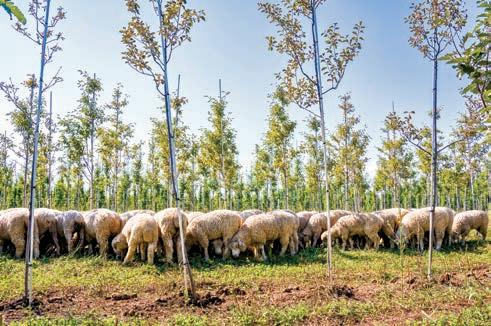
Gilles Lapointe completed 16 years of post secondary studies earning him a BSc in agronomy, a MSc and a doctorate in plant physiology, biochemistry and genetics. Following a long career in the plant world he led a landscaping company in Mississauga for 15 years and then moved into R&D on sustainability and soil health on tree nursery grounds. He became an expert consultant on soil health, cover crops and sustainability through his applied scientific studies. He is an independent consultant helping other nurseries and standard agriculture farmers to improve their soils and management to reach sustainability.

Kubota engines offer the flexibility and performance to fit any application. Their easy maintenance, high power density and low fuel consumption mean more productivity and unbeatable profitability.




 INTERVIEW BY SCOTT BARBER
INTERVIEW BY SCOTT BARBER
Alan White is a champion for the power of plants to clean the air we breathe, cool our cities, and capture carbon. White often says that plants are the lungs of our cities, and landscape horticulture professionals are critical to climate change mitigation and adaptation.
White is the owner of the BurlingtonOnt. based lawn care and irrigation firm Turf Systems. He also volunteers with the Canadian Nursery Landscape Association (CNLA) as chair of the Climate Change Adaptation Committee and chair of the Green Cities Foundation. He is also a director on Landscape Ontario’s Provinical Board.

White recently joined the Landscape Ontario Podcast to discuss why now is the time to capture the attention of public policymakers, governments, and most importantly, the general public to ensure they recognize the value of what green professionals do: growing, designing, building and maintaining green spaces.
How did you get engaged on the climate change topic?
For the last couple of decades, the story around climate change mitigation has been the ability to manage our carbon footprint. The emissions side has been the dominant piece of it. However, being part of the horticulture industry and understanding that plants are at the core of intercepting carbon, I was curious why plants weren’t part of the conversation. Why wasn’t anyone looking at the other side of the equation; the power of plants to sequester carbon while at the same time producing cleaner, cooler air?
I believe if our industry can work together to share that story, that story, there is incredible potential to make a positive impact and to be leaders on this critical issue. We can ensure plants play an essential role in the race to net zero.
Why haven’t plants been part of the conversation?
A lot of it has to do with the fact that it’s something we learned in grade nine or 10 science. We all know plants capture carbon and produce clean oxygen, but it’s almost too simple or obvious. So we look for complex solutions. And when you have a conversation with someone about where
WHEN HAVING THE BEST QUALITY , YEAR-ROUND, INDOOR/OUTDOOR FIBERGLASS PLANTERS IS IMPORTANT, KNOW THAT YOU CAN’T DO BETTER THAN THE JAY SCOTTS BRAND FROM

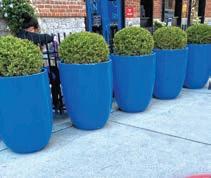

• SMOOTH PERFECT FINISH.
• UV PROTECTED FROM THE SUN’S PENETRATING RAYS. NO FADING.

• IMMUNE FROM OUR COLDEST, MESSIEST WINTERS.
• WON’T CRACK OR BREAK.
• REINFORCED SIDES TO PREVENT BULGING.
• SPACE UNDERNEATH TO ALLOW FOR WATER RUN OFF.
• WIDE SELECTION. TWO WEEK LEAD TIME. AVAILABLE IN 20 COLOURS. NO MINIMUMS

clean air comes from, people look at you with kind of an astonished look, because they knew that, but they had never applied it to climate change adaptation before.

If we can shift the public’s understanding, I know we have a compelling story to tell. Plants are something that everybody can participate in. It doesn’t matter if it’s turf grass, the flowers in your garden, a tomato plant on your balcony or a tree — all of them metabolize carbon the same way, and the result is they all capture carbon and produce oxygen.

Of course, like every industry, horticulture professionals have a carbon footprint. We have inputs like fertilizer, and water. We utilize vehicles and equipment that use fossil fuels. Do we need to understand what we’re doing to mitigate our emissions? Absolutely. Can we be better at it? We can always strive to be better, but we genuinely need to understand how the inputs, the things that support life in urban ecosystems like water, nurturance and care, how do those things contribute to carbon carbon sequestration and the production of clean air? And we need to recognize as an industry that we are unique in that there is nothing outside of
plants that contributes in a positive way to the carbon equation. So let’s focus on that positive while striving to be as efficient as possible.
How do we ensure horticulture professionals are part of the solution?

That’s the big question I’ve been working on really for the past two decades. Something I learned early on in business is that you need to be unique in what it is that you’re bringing to the marketplace. You need to have a solution and a story that is uniquely yours and allows you to rally around it and make a difference. And you also need to be able to measure it. You have to quantify what it is you want to change. And then, through that quantification, build the power of participation.
Our industry has an incredible network, when you look at the more than 4,000 CNLA members across the country, and the tens of thousands of people who work for those companies, and then expand out to the millions of clients who are positively impacted by the work that we do. There’s immense power in that network if we can
find a way to harness it. That’s why the Green Cities Foundation is working hard to develop a clean air calculator that everyone — industry professionals and the general public — can use to measure the positive impact they are making with plants.
How does the clean air calculator work?

The Green Cities Foundation aims to connect plants and people for a greener, healthier urban climate. That includes both the individual level — what am I doing in my yard or balcony to produce oxygen — and the group level with the #GreenMyCity initiative. Those projects engage and empower people to participate alongside professionals to make a difference in the community.
The next step with the clean air calculator is to empower people to measure the impact that plants, shrubs, understory landscape, grass and open green spaces contribute to the environment. By providing the tool to quantify the impact of plants, our goal is to give people hope that they can make a positive difference in their communities.
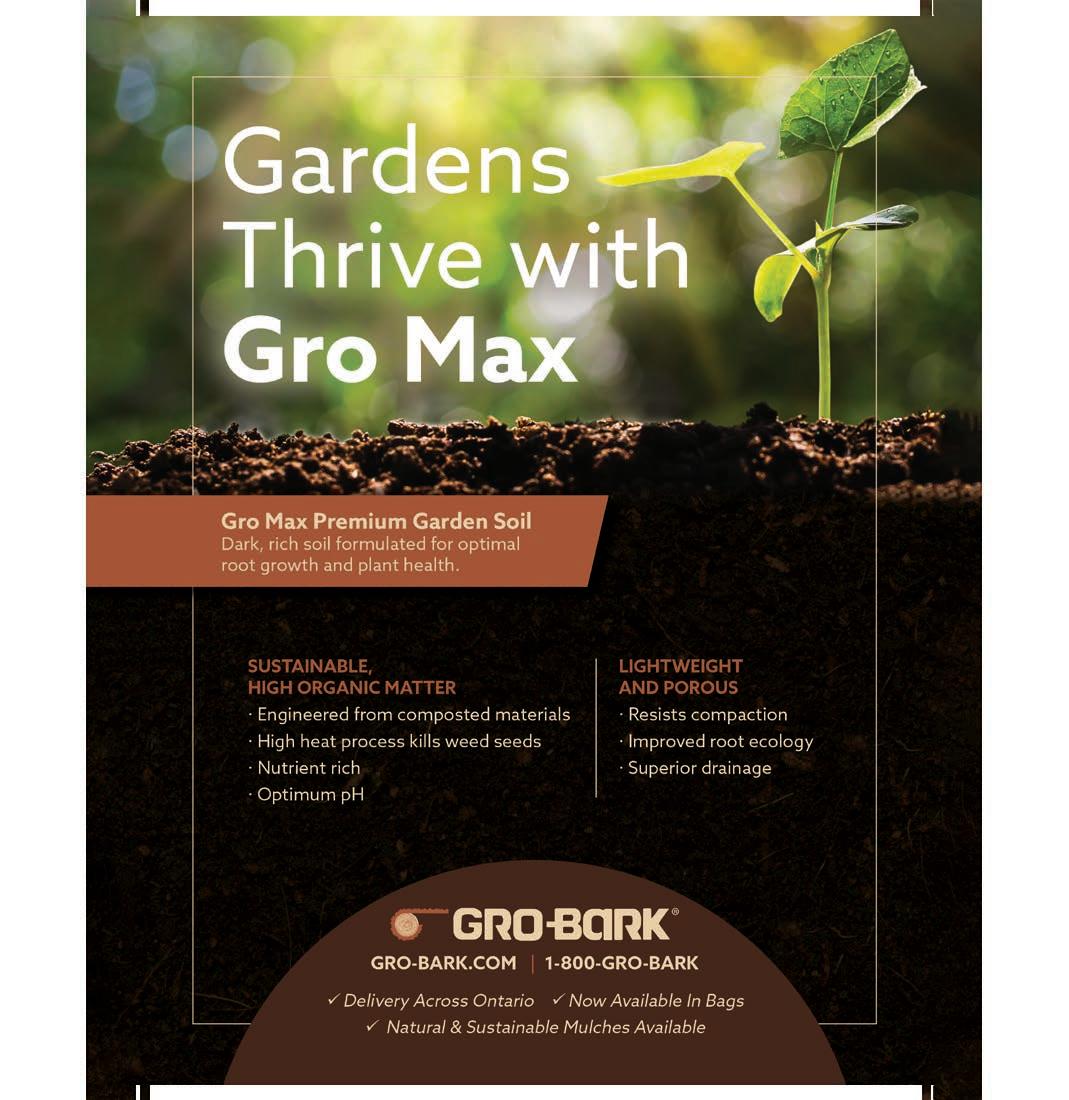

Brett Hitchins is a Vancouverbased commercial photographer and the owner of Brett Ryan Studios. He grew up on a family farm outside Kingston, Ont. and began his career in landscape architecture as a design consultant and project manager. His daily work focuses on portfolio imagery for distinguished architects, landscape designers, and engineering firms, helping to communicate the value of their work through multidisciplinary visuals. Hitchens is a nationally accredited member of the Professional Photographers of Canada and seeks to capture the experiences that unfold in our built environments.


How did you get into landscape/ garden photography?
I began my career in landscape architecture. I’ve always been oriented toward visual arts, graphic design, and anything image related. After graduation from the Landscape Architecture programme at University of Guelph, I moved from Ontario to Vancouver. For several years I worked at a mid-size firm specializing in large scale commercial projects. While I was there, I championed many of our firm’s marketing materials, designing our website, proposals, and coordinating award and publication submissions. We didn’t have strong photography for all our portfolio projects and eventually I started going to sites and documenting the work myself.
I invested in a camera and enrolled in a few photography courses at a local school to improve my skill set. I started taking more courses on nights and weekends. I grew to love it and eventually some other consultants in the area began hiring me to capture their projects. Within a few years, it quickly turned into a full-time business.
When I made the career transition to photography, I was fortunate to bring a considerable network of contacts from the design and consultant industry. The landscape architecture community is very niche and those relationships have led to many opportunities capturing high-end private residences and luxury homes and gardens.


My first impressions come from the relationships with the main residence and within the site. I want to understand how people live in and use the spaces throughout the property. How did the designers solve the site constraints, which opportunities did they make the most of, and what does the final outcome offer a homeowner and guests?
From there, I am drawn to the details. How well thought out and executed is the construction? What materials were chosen? How are corners treated? How do surfaces interact? What’s the relationship between softscape and hardscape? How is the planting layered? Photos that capture those ideas add value.
Lastly, I try to imagine how the site will look throughout different seasons and in a few years. What is worth returning to capture, like spring blossoms or colour fall foliage. I like to find textures and shadows that create abstract photos. Those images can help communicate design themes that are difficult to capture, ideas like a sense of mystery, simplicity, or harmony.
The purpose of photographing any site is to tell its story. At the end of the assignment, you should be able to sit down with someone who knows nothing about the project and share what makes the project successful from the final image collection.
My advice is to focus on creating meaningful image collections rather than just a few nice images. Create a shot list with key vantage points, capture images of the important spaces at various scales, and photograph gardens across the day as the light moves throughout the site. People often overlook details and textures, however, I find they make for some of the most interesting imagery. They give space for the viewer to immerse themselves in the project, to think about the hidden design ideas and thematics, and quickly communicate the effort involved in the craftsmanship.
Because gardens and landscapes evolve throughout the seasons and years, I think it’s important to shoot with the mindset of capturing the story at this place in time. Don’t photograph with the intent of capturing content for a social media post. I think it’s better to think in the context of legacy projects, like a book. I want to create a collection of images that the designer can look back on 20 or 30 years from now and remember their work. Or that a family can look back through an album and remember a point and time within their lives.
For more tactile advice, it’s important to control perspective, keep parallel lines straight, and shoot in good light. Early in the morning, towards dusk, and into the blue hour are the best times to photograph. And overcast days are typically better than sunny days because the soft light creates less contrast between bright highlights and shadows.



What are some of your favourite gardens you have photographed?
There are a lot of beautiful properties in the greater Vancouver area. I love the Pacific Northwest design aesthetic with clean lines, contemporary architecture, and timeless materials. Many homes out here have mountain views or strong connections with the water, which are exciting to capture. I have a close relationship with many highend designers and contractors. Some of my favourite projects are Paul Sangha Creative’s work. Their design team is incredibly dedicated and their projects are fantastic examples of the value that design can offer a homeowner.


What is your favourite camera gear for shooting gardens?
I capture most of my architectural photography with a Nikon system and love the 19mm tilt-shift lens. The imagery is sharp and vibrant when working on a tripod and the lens allows me to control perspective in the camera. For softer focus and cleaner colours, I have a Canon mirrorless system. It’s smaller and easier to carry, and the images translate nicely from the camera to Lightroom. Longer focal lengths work best for isolating details. For drone imagery, I use a DJI Mini 3. Drones have come a long way in a short time. To get 4K aerial imagery from such a small piece of equipment at less than the cost of most professional lenses is an incredible value. LT










IN MY LAST COLUMN, you met Dr. Tim Rademacher, a self-proclaimed “scholar of trees and technology,” and his arboreal counterpart, Whitney, a century-old red oak tweeting from the Harvard Forest in Petersham, Massachusetts. Via the Twitter account @awitnesstree, Whitney keeps her 10,000 plus followers informed about her sap flow, secondary growth, and how she “feels” about — and reacts to — extreme weather events.
Whitney was not the first tree to have a Twitter following. Like me, Tim was inspired by colleagues at Ghent University, who set up the world’s first tweeting tree in 2016, and currently monitors sensor data from 21 trees across Belgium, Germany, India, the Netherlands, and the UK. The 10-year project is known as TreeWatch.net. On a warm summer day, the tree on Wageningen University & Research campus proudly proclaimed: “Today, I have grown 0.082 millimetres, transported 124.9 litres of water at a maximum sap flow of 9.8 litres per hour.” By studying the live data output from trees, researchers are able to gain
insights into how plants responded and adapted in past climates of distress. This information can then be used to create predictive models that will help shape our future understanding of urban forests.

In 2021, renowned tree biologist Dr. Andrew Hirons and I were tremendously inspired by both TreeWatch.net and Tim’s live-tweeting brainchild. We felt, however, that more could be done to raise awareness on the plight of city trees and the underground world of soil health, which in large part determines the health of the tree. Thus, with the support of UK community forest organization, Mersey Forest, and Dutch soil sensor company, SoilMania, our own tweeting tree — @bowiethebirch — was born. Let me introduce you to Bowie.
Like Whitney, Bowie makes use of sap-flow sensors to measure his vascular health like a heart monitor, a dendrometer to measure his growth, and relative humidity and temperature sensors to understand his microclimate. What makes Bowie unique is where he lives — he is one of the world’s first urban tweeting
trees, dealing with uniquely urban issues like soil pollution, compaction, heat island effect, urinating dogs, and more. Bowie is also connected to a state-of-the-art soil life sensor from SoilMania, which in addition to Bowie’s tree sensors, measures soil moisture, pH, electrical conductivity (salinity), temperature and oxygen levels.

Imagine you’re standing in front of a maple tree. It has paler, smaller, and fewer leaves than in previous years that have changed to fall colours far before the end of summer. How would you go about diagnosing that tree?
Our most immediate reaction might be to look up at its crown, but in order to assess the overall health of a tree, it is essential to understand what lies beneath the surface. While many arborists and green professionals may focus on looking up at the leaves and branches, they often forget to look down into the soil. Health starts from the bottom, as the nutrient-rich soil that contains diverse organisms critical for growth gives trees a reliable foundation. If a tree’s root system lacks nourishment or experiences disturbances, then it will be unable to support healthy growth above ground. And without a strong root system, any efforts to help trees stay healthy are likely to be in vain. Soil is what trees grow in, providing support, nutrients, and a network of water and air to the plant’s roots. Farmers obsess over soil health to ensure a healthy harvest. Why don’t we do the same when growing trees in the city?
Soil life sensors are a powerful tool for understanding soil health. By measuring soil moisture, pH, salinity, temperature and oxygen levels, these sensors can provide insights into the nutrient content of the soil, the presence of pollutants and potential contaminants, as well as an early warning sign of problem areas in the ecosystem. The data collected will allow you to witness the immediate impact various factors have on soil health and with that, observe how vital
it is for tree and shrub growth. Events and interventions like mechanical pressure, weed control, fertilization or weather conditions are now visible in real time.





That data could be kept to arborists, urban foresters and municipalities — or we could use it to achieve an even greater goal: revealing the hidden life of trees to urbanites around the world. By translating tree and soil data to automatic — and most importantly, fun (!) — tweets, Bowie is like a digital Lorax, speaking — or rather tweeting — for the trees. We might not be able to see it, feel it or hear it, but under our feet lies
the matrix that can make or break a tree’s life. Especially in a city where trees face increasingly harsh conditions.

By communicating about the growth, challenges and opportunities Bowie faces, citizens can learn about the importance of healthy soil to grow healthy trees in cities for generations to come. But we didn’t want these lessons to stay only in Liverpool, where Bowie lives. Creating Bowie led to the development of SoilMania’s Tweeting Tree Kit, which comes complete with everything you need to set up your very own digital Lorax. It’s a unique and innovative product which can be installed on any tree of choice, acting as a representative for all of the city’s trees, like a “tree mascot” for the community.
My hope for the future is to establish a network of tweeting trees across the world, fostering respect and appreciation for nature in our ever-evolving world.

Interested in plugging into the tweeting tree network yourself? Findings from Bowie’s case study have revealed the power of the Tweeting Tree Kit to create meaningful engagement among communities and bolster tree-growing initiatives. These positive results have sparked interest amongst a number of organizations, from hospitals to university campuses, landowners, municipalities and more! All of whom are looking to improve the relationship that residents have with urban trees in their environment. Through tweeting, urban trees gain a voice to bridge the divide between city-dwellers and nature. Streets cloaked in green whisper secrets of kinship for all who lend them an ear.
GALLE spotlights Internet of Nature (IoN) technologies and practitioners making a difference in how we can optimize soil health, manage urban forests, create liveable cities, and everything in between. To learn more about the IoN and to catch episodes of the Internet of Nature Podcast, visit: nadinagalle.com.
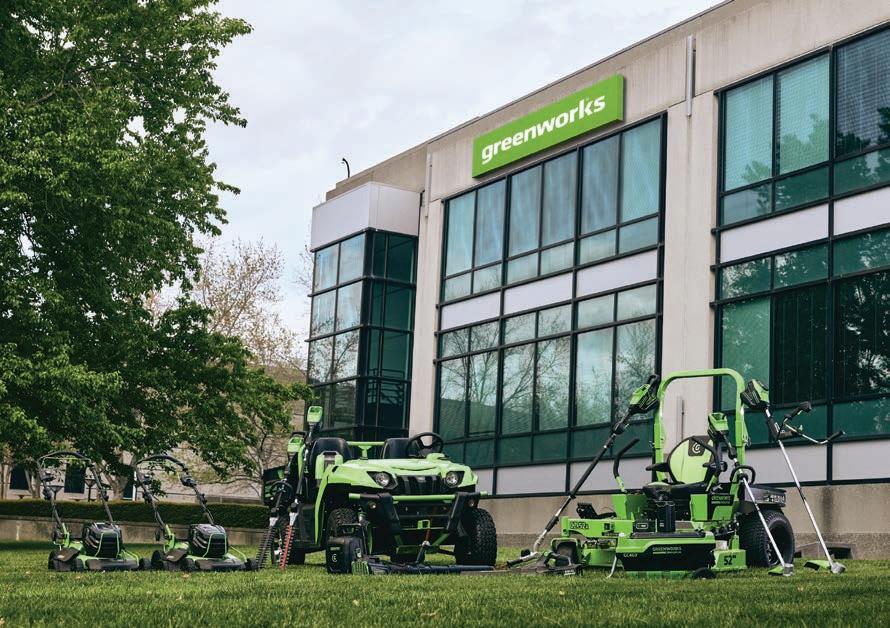


THE GOAL for all design/ build companies is to acquire the best customers and capture revenue for all the work they do — including the project design. The design is the most important part of building a brand people are willing to pay for.
A landscape is concrete, yet at the same time it is a living organism that either appreciates or depreciates over time. Design is the foundation upon which true long-lasting value is built. It’s not an expense, but rather an investment. The benefits are financial, environmental, social and emotional.
1. A revenue source to pay for talent and keep it.
2. The ability to generate revenue and profit for your company.
3. A differentiator that validates we are good enough to charge you.
4. A screening tool to separate customer wheat from chaff.
5. The plan to execute the vision perfectly.
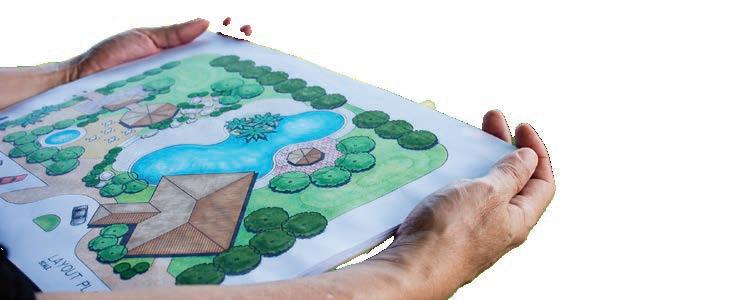
Charlie Munger, Warren Buffet’s billionaire business partner, stated it best: Most people are driven by envy! A simple test of this assumption is the concept of buying a car. Ninety-nine per cent of cars today are reliable and safe with similar features, such as: fuel economy, automatic transmission, air conditioning, and seating for five people. The speed limits are the same for a Honda Accord or a BMW M3. One costs $30,000, the other $70,000, yet they essentially do the same thing. The perception in the marketplace of the value of the vehicles and the status they bring account for a giant delta in price. The same concept holds true for design: Frugal or wow!
The biggest obstacle to charging for design is the fear of having no work. It is a rational emotion based on a perceived existential threat. The risk assessment, however, is not logical if emotion and not statistics governs the decision to charge or not to charge for design.






Step 1: Charge for the design and credit the client if they hire you, but build it into your cost.
Step 2: Charge for the design for a fraction of your clients, with no offer of a credit but at a lower price.
Step 3: Charge all of your customers for the design with no credit at a lower price.
Step 4: Start raising your price incrementally over time to all your future customers.

My own company Oriole Landscaping did this, but we skipped step two. All the companies I have consulted have started charging for design with zero regrets. Boutique landscape designers and architects make their living purely off design.
Planning is never free. They say the Japanese take two years to plan and one year to build, while North Americans take one year to plan and two years to build. Perception is reality, and the reality is often undervalued. Sell your process — you have to show your clients you are the right choice. More people are willing to pay for the design than you think.
LTis the cofounder and president of Oriole Landscaping in Toronto, Ont. He is now on the second phase of his career acting as a business consultant for Knowledge Tree Consulting, a company co-founded with Peter Guinane.


the expiry of claims for contractual liability or negligence in Canada are tied to limitation periods set out in various pieces of legislation. In Ontario, for example, the Limitations Act, 2002, establishes a general limitation period of two years (from the date the claim is ‘discovered’) and (in most cases) an outside limitation period of 15 years. Similar statutory limitation periods (with varying timeframes) are in place across Canada. These general limitation periods can be ‘trumped’ by more specific legislation in some cases (for claims against Municipalities in most jurisdictions, for example).
Significantly, however, the statutory expiry of claims can also be overruled in contract, by agreement of the parties. It is this ability that will be addressed in this article.
First, contract documents can simply provide that a party will not be entitled compensation for certain impacts or breaches of contract. As the Supreme Court of Canada made clear in Tercon, for
example, so long as the clause is clear (and not unconscionable) the Courts will not interfere with the parties’ right to negotiate what a party can and cannot pursue a claim for. Such clauses commonly include where the contractor is precluded for making any claims for delay or where a bidder is precluded from making any claim arising from an owner’s breach of its obligations in a tender process. We also note that proving ‘unconscionability’ (which could override the contractual exclusion) involves a very high bar.
Parties can make a claim conditional on certain conditions being met (often referred to as ‘conditions precedent’). They might be required to give formal notice of a potential claim within a certain period of time, for example. They might also be required to provide detailed backup to the claim and/ or initiate dispute resolution within certain time periods, failing which the claim will
be extinguished. Although such clauses are common to Canadian standard form contracts, they can vary widely (through supplementary conditions or in nonstandard forms). Canadian courts have also established that, unless it can be established that a party somehow waived the application of a contractual condition precedent, claim will be lost if the condition is not met.
Our courts recognize that a covenant to obtain insurance can create “tort immunity”: that where one party agrees to insure itself and others against a particular risk, it cannot then sue the others if the risk materializes — even if they fail to take out the insurance. The covenants are often given so that everyone in the contract ladder doesn’t need to charge for insurance against the same type of risk (such as fire, flood, other property damage or theft). The tort immunity only applies to the extent that the insurance was intended to cover the loss or damages in question.
SAVES TIME AND YOUR BACK.
Simplify your daily operations and ease manpower with a Side Discharge Bucket from HLA.
Spread material to the left or right with no hydraulic setup changes, less machine settings means more time to get the job done.
519.291.4162
www.hlaattachments.com





Contracts can also be drafted to forestall claims by limiting the extent to which one party will be entitled to be indemnified by the other. Standard from CCDC contract language, for example, allows for indemnification only where notice in writing within a specified event or date has been given, and in relation to claims caused by the negligence or breach of contract of the party from whom indemnification is sought (or anyone for whom that party is responsible). The right does not extend, under such language, to claims for indirect, consequential, punitive or exemplary damages. The right is also at times limited, in relation to certain types of claims (only) to the monetary limits of the insurance taken out by the party that has to indemnify.


It is not uncommon for construction contracts to provide that upon a certain date or event (such as substantial completion or the owner’s taking over of the project, which is common under Canadian standard forms) each party will waive and release the other from all claims for breach of contract or negligence they have, subject to certain exceptions. The exceptions commonly include claims resulting for acts or omissions which occur after the date or event in question, claims for which notice has been given prior to that date or event, indemnification for claims advanced by third parties which can be asserted under the contract or subcontract (see above) and claims of various specific kinds (such as those environmental claims).
These clauses can be significant not only because they will limit the ability of the other contracting party to pursue certain claims, they can also stop third-parties from making claims. This, because a party that is protected by a valid contractual limitation of liability for certain conduct

cannot generally be called on to contribute to pay the damages suffered by a thirdparty as a result of the same conduct. By way of example, then, if an owner cannot sue its contractor for construction that (in part) caused a building to fail, but sues its architect or engineer for their role in the same failure, the architect/ engineer cannot generally bring the contractor in by way of a third-party claim where the owner has waived its claims against the contractor. Waiver clauses, then, can provide substantial protections against liability claims.


The contractual provisions discussed above deal with the exclusion and expiry of a claim. It should also be noted that a claim’s expiry can also generally be suspended, or extended, by agreement between the parties, through what are often referred to as ‘tolling agreements.’ By way of such agreements, and depending on the terms of applicable limitation period statutes, the parties can agree to suspend or extend the expiry of a claim either indefinity or to a specific date.
The importance of tolling agreements should not be underestimated in construction, particularly given the Supreme Court of Canada decision in Grant Thornton LLP v. New Brunswick, 2021 SCC 31, which held that the clock starts ticking when a “plausible inference” of liability arises on facts that are, or ought to be, known by the claimant through the exercise of reasonable diligence. It is not unusual for a party to know about a potential claim long before they might decide that the claim is worth pursuing, such as where a party might know it has suffered a deficiency or impact (such as delay) but is not sure that the dollar-value would be worth pursuing, where the fact of a deficiency is known but the severity is not and where a contractor or trade is working at, but yet completed, the correction of a known defect. In such circumstances, a statutory limitation period can creep up on the parties very quickly. The parties might accordingly wish to formally ‘toll’ the expiry of the claim(s), to allow for investigation and/ or negotiation, etc.

Although we have provided examples drawn from standard form contracts in use across Canada, it is important to recognize that the bounds of what parties can agree to are almost (though certainly not entirely) limitless. Clauses which set out what claims will be excluded, what conditions precedent will be placed on claims and how and when claims will be waived or expire can go well beyond the norm, yet still be enforceable (except in limited circumstances). Covenants to insure or indemnify might also go well beyond what is usually provided for. It is accordingly very important that parties review proposed or draft contracts to assess how these types of provisions will impact their risk.
The Canadian government announced it is providing the Canadian Agricultural Human Resource Council (CAHRC) just over $12 million for their Growing the Agriculture Workforce of the Future: Cultivating Canada’s Post-Pandemic Recovery Project. The funding is part of Employment, Workforce Development and Disability Inclusion’s (ESDC) Sectoral Workplace Solutions Program (SWSP) that helps key sectors of the economy implement solutions to address workforce needs.
In a media release, the Trudeau government says by identifying skills most in need, providing innovative and targeted training programs to 1,175 employers and employees and by setting sector-wide standards for recruiting and retention, this project strives to
meet the current and future demands of the agriculture industry. The 17-month initiative includes:

• Forecasting labour market shortages and skills needs,
• Developing an inventory of current and future skills needs,
• Developing training programs for job seekers and new employees,
• Expanding CAHRC’s HR Management program and developing a recognition program for employers.
Forty per cent of employers surveyed in primary agriculture in CAHRC’s 2021 Understanding the Effects of COVID-19 on Canada’s Agriculture Workforce research reported not being able to fill vacancies and the industry suffered earning losses of $2.9 billion in total sales, directly attributable to
unfilled vacancies tied to the pandemic. This is nearly double the $1.5 billion in lost sales recorded in 2014.
“The Canadian agriculture and agrifood industry is an economic driver for Canada while at the same time feeding Canadians and the globe,” said Paul Glenn, CAHRC Chair. “Industry has come together through the National Workforce Strategic Plan to identify actions to address the chronic labour shortage and ensure the industry has the workforce to remain a global leader in the supply of sustainable, quality agriculture and food products. The funding provided by ESDC through the Sectoral Workplace Solutions Program (SWSP) will allow for the swift implementation of many of these actions identified by industry in the Plan.”


creatives and the world as you step out into your next chapter. You are the future of the design profession and can make a difference! We can’t wait to see what you have in store.”
Submission deadlines and prize award amounts differ based on the applicant’s country or region. For additional information and to apply, visit vectorworks.net/scholarship.


Global design and BIM software provider Vectorworks invites students to see where their designs can take them by entering the seventh Vectorworks Design Scholarship. The global competition is open to undergraduate and graduate students in major disciplines related to architecture, landscape architecture, landscape design, entertainment and interior design. Students can submit a new design or past project from any of their classes for the chance to win up to $10,000 USD.
“It’s clear that today’s student designers have limitless potential,” said Vectorworks Academic Marketing Programs Specialist Jen Hart. “We’re honored to have the opportunity to showcase their creative talents and innovative designs but also help to foster their future careers through the exposure and financial assistance this competition can provide. We encourage all students to take advantage of this unique opportunity to shine a light on their achievements as they embark on their professional journey.”
Competition entries will be evaluated by an expert panel of international judges in two rounds. First-round winners will each receive up to $3,000 USD and will be entered for the chance to win the grand prize Richard Diehl Award, worth up to an additional $7,000 USD. Winners’ schools will also receive free Vectorworks Design Suite software and free virtual or in-person workshop training for faculty and students.
“Our differences, quirks and dissimilarities are what is interesting about us; they are a life force of any society,” said Cristina Murphy, cofounder of XCOOP, adjunct professor at Virginia Tech, Washington-Alexandria Architecture Center, assistant professor at the School of Architecture and Planning at Morgan State University and one of this year’s judges. “Share your distinctive abilities with fellow designers,
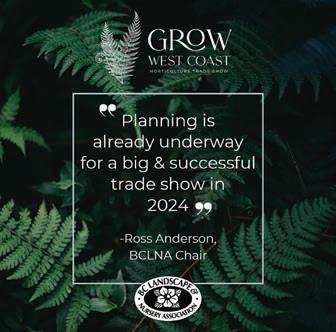
The British Columbia Landscape Nursery Association (BCLNA) announced the Grow West Coast Horticulture Trade Show (GWC) will be reimagined for a 2024 re-launch. The annual trade show has been a cornerstone event of the association for 41 years. BCLNA is excited to bring new levels of inspiration and exceed the expectations of attendees and exhibitors next year.

GWC has evolved over the years, with different locations and formats to meet the needs of the industry. Most recently, GWC ran as a smaller, outdoor market-style event to comply with COVID-19 restrictions. Given that these restrictions are no longer in place, the opportunity to host a larger event is now an option. The association has a refreshed team of directors and staff who are eager to plan a show that will leave a lasting impression on all those who attend. Ross Anderson, BCLNA Chair, says, “Planning is already underway for a big and successful trade show in 2024.” Although there will not be a trade show in 2023, BCLNA is looking forward to seeing everyone at an event this year, to celebrate its 70th anniversary.
The BCLNA is committed to creating an event that will be worth the wait and will provide an exceptional experience for attendees and exhibitors alike. The association will keep everyone updated with further details as they become available.

Unilock announced it is continuing the Paving the Future Scholarship program launched last year in celebration of the company’s 50th anniversary. The program awards selected landscape and landscape architecture students in Canada and the United States $5,000 each to help pay for their education expenses including tuition fees, books, housing, and transportation costs.

“Ed Bryant is remembered as founder of the Unilock Group of Companies and the pioneer who first established a paver manufacturing site in North America in 1972,” the company said. “His passion, collaboration and innovative spirit brought an ecosystem of partners together to kick-start the hardscaping industry - Manufacturers, Dealers, Architects, Installers, and Sales Teams – all working to pave the way forward in a
completely undefined space. Bryant’s vision of building the industry in a way that benefits many drives us to continue to invest in the communities to which we belong. The Unilock Paving the Future Scholarship commemorates the company’s late founder Ed Bryant’s legacy by investing in a new generation of landscape design, architecture, and construction leaders. This scholarship program recognizes students in their final year of study who are active members in their community and demonstrate an ambition of being a thought leader in the landscaping industry of tomorrow.” Applicants must submit their applications to Unilock by the deadline of August 31, 2023 and winners will be notified by Oct. 10, 2023. For full details, visit: unilock.com/paving-the-future-scholarship-landscape-construction/.





The AIPH World Green City Awards recognize and celebrate bold and innovative action that harnesses the power of plants and nature to create greener, healthier, and more resilient cities. The 2024 edition is offered in seven categories, with three finalists in each category from which one category winner is selected, and with one Grand Winner chosen from the seven winners. Entries are compiled and submitted by cities through an online portal which is open for six months until the submission deadline on Sept. 15, 2023.
“Time and time again, we are seeing how plants and nature provide the solutions to many of the challenges facing our planet,” said Tim Briercliffe, Secretary General, AIPH. “It is also increasingly evident that cities are uniquely positioned to harness this potential and drive transformational change. The impressive, bold, and innovative initiatives showcased through the inaugural edition of the AIPH World Green City Awards set the stage for an even more ambitious demonstration of the power of plants in the 2024 edition.”
The global reach and success of the inaugural 2022 edition of the AIPH World Green City Awards is evident in the fact that it attracted entries from close to 60 cities from 40 countries on all seven continents. Building on this impressive legacy, the 2024 edition seeks to showcase even more inspiring initiatives from an even larger number of cities.
The AIPH World Green City Awards champion ambitious nature-oriented approaches to city design and operation. Specifically, they seek to recognize initiatives relying on a greater use of plants and nature
to create better city environments — helping to fulfill local aspirations for improved economic, social and environmental resilience. Cities are invited to enter the AIPH World Green City Awards 2024 to show to the world their achievement and commitment to nature-oriented solutions that harness the power of plants and associated ecosystem services to help address the major challenges facing cities. Cities benefit from entering the awards by the global recognition they gain through case study profiles in the AIPH Green City Guidelines, feature presentations in the AIPH Green City Briefings, and engagement with a global network of green city professionals on the AIPH Global Green City Forum.
“Cities are champions for the power of plants and nature. Now, more than ever before, we need cities to show the world how collective action at the local level can achieve global impact. That is why all cities are invited to enter the AIPH World Green City Awards 2024. There is so much to gain — for cities, people, and planet,” said Bill Hardy, Chair, AIPH Green City Committee.
With feedback coming in from our latest survey we are starting to gather a picture of what is really important to designers and where many different types of design offices and professionals are.
If you haven’t filled out the survey yet, please go to: www.surveymonkey.com/r/JPJ3VDD
It is often forgotten that many designers are in stand-alone businesses, or sole proprietorships. It also came to our attention that many people doing design don’t necessarily go by the title landscape designer. Often, they are in sales, estimating, or marketing positions but are doing designs for clients coming to them. This is especially true in the case of design/ build firms.
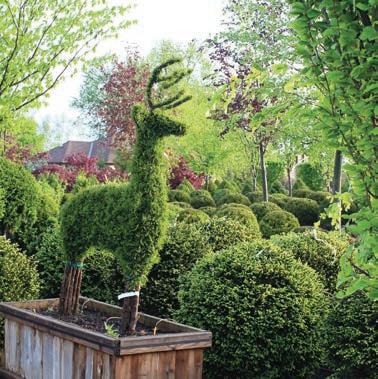
As we continue to see results from the survey, the renewed energy and direction of the committee will crystalize. We want to ensure that effort is being put into the concerns and programs that offer the greatest assistance and advantage to our network of professionals.
The committee is also reaching out to other allied associations to discuss mutual concerns and ensure that we are all in alignment going forward. This includes provincial landscape architecture and professional landscape designer associations as well as national landscape architecture associations in both Canada and the US.


There is a comparable network that meets annually called the Great Lakes Association. The members are American member states that touch on the great lakes as well as Ontario. The presidents and executive directors of each association gather for two or three days to discuss annual successes and challenges. These cross-border discussions have led to valued growth and exchange of ideas between many like-minded groups.
As this design committee gels and finds common paths and languages between the groups this could well lead to a national or international design conference down the road. Leave it to designers to create new networks and pathways.
I appreciate all your feedback and input to date and look forward to meeting you in person.
Paul Brydges Chair National Design Subcommittee – CNLAIsuzu announced its first all-electric production model, the N-Series EV will be available in the first half of 2024. The 2025-model-year Class 5 truck features a full 19,500-pound gross vehicle weight rating, a battery electric platform developed by Isuzu Motors, and an all-new cab design.

isuzutruck.ca


ASV introduces the VT-100 and VT-100 Forestry Posi-Track compact track loaders. The new VT100 compact track loader is a vertical lift machine that excels in loading and grading applications in landscaping and construction. The VT-100 Forestry is suited for mulching, right-of-way clearance, site prep and more.
ASV asvi.com
The Develon DX89R-7 mini excavator replaces the DX85R-3 and packs many of its predecessor’s features with enhancements such as greater lifting capacity and more horsepower. This nimble machine is equipped with a family of products, including a Develon engine and diagnostics tool.
Develon
na.develon-ce.com

CASE Construction Equipment is bringing back the iconic “Construction King” name and releasing five new backhoe loader models to the North American market. Two models are available immediately: the CASE Utility Plus and the CASE 580SV Construction King Center Pivot. Three additional models will hit CASE dealers later this year.


casece.com




The next generation of Cat 926, 930 and 938 Wheel Loaders offer a range of new technologies and features designed to boost productivity by simplifying machine operation. Adding flexibility by design, the versatile Cat small wheel loaders offer industry-specific configurations to efficiently handle agriculture, waste, forestry, aggregate and snow removal applications.
Caterpillar cat.com


Dewalt’s 20V MAX 8-in. Cordless Pruning Chainsaw has a high-efficiency brushless motor designed to maximize runtime and motor life with up to 70 cuts per charge. It is designed to trim branches from downed trees and manage thick brush for daily pruning needs.
Dewalt dewalt.ca
 #1 Kentucky Bluegrass | Low Mow | Extreme or Tall Fescue | Native or USGA Bentgrass | Large or small rolls
#1 Kentucky Bluegrass | Low Mow | Extreme or Tall Fescue | Native or USGA Bentgrass | Large or small rolls


The Tamper Mat Pro #510 attaches to many different plate compactors with its universal size of 19x24 and .25-in. thick. The high-modulus polyethylene thermoplastic mat comes with two pairs of universal aluminum mounting brackets and can be cut down for smaller sizes.
Brickstop
brickstopedge.com
Banas Stones introduces Banas Silver Sapphire Granite to all of its natural stone product lines for 2023.

Banas Stones
banasstones.com
Molina 60-mm slab from Oaks Landscape Products is a durable, super smooth EliteFinish face-mix product, with the added benefit of ColorBold to help maintain vibrant colours and stain resistance. Perfect for patios and pool decks, the smooth surface, clean edges and reduced joint spacing give exterior floors a sumptuous and refined look. New for 2023, 12x24-in. and 24x24-in. sizes, available individually packaged and in four colours.
Oaks Landscape Products
oakspavers.com


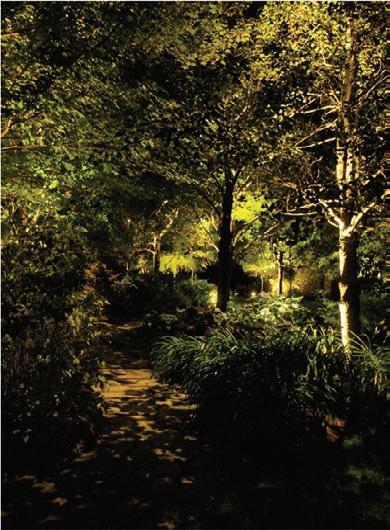
Milwaukee Tool’s M18 Fuel Brush Cutter is designed for professionals. Featuring a Powerstate Brushless Motor, this brush cutter maintains the ability to sustain power underload without bogging down, powering through the most demanding of applications.
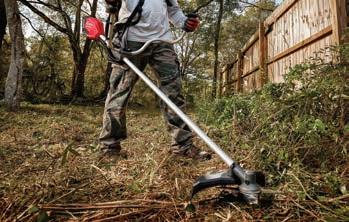
Milwaukee Tool milwaukeetool.ca

CoverNgo retractable seat covers for Moffett truck-mounted forklifts are now more durable than ever. Cool in summer, warm in winter and clean and dry in all seasons, they make it easy to get comfortable in seconds and save time. All new Moffett NX models in Canada come with seat covers already installed.
Atlas Polar Company atlaspolar.com

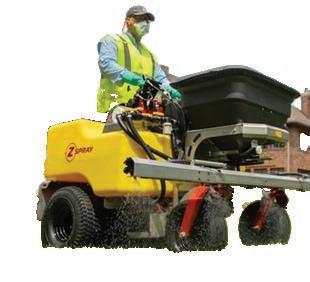

Z Turf Equipment has redesigned its Z-Spray line of zero-turn standon spreader sprayers to place the operator between the drive wheels, with components placed low and centrally within the corrosionresistant stainless-steel frame. A bi-directional boom springs both forward and back to avoid damage. A contoured operator pad and revised control layout provide increased comfort and economy of motion, while larger drive tires ensure a smoother ride.

zturfequipment.com


Husqvarna’s 525iDEPS Madsaw dielectric pole saw can be used in the bucket, in the tree, or on the ground for extreme versatility. Purposeful design allows the pole saw’s sections to quickly disconnect for secure storage in a tree care truck or utility vehicle.

Husqvarna
husqvarna.com
SatQuote has launched a new map-based property intelligence, measurement, and estimation software platform that enables landscapers and lawn care operators to manage all aspects of measuring, designing and quoting jobs. SatMeasure Technology is a suite of tools that provide property owner information, boundary data, drawing and map manipulation features, high-resolution imagery and AI measuring assistance.



SatQuote satquote.com


Caterpillar announces a range of new Cat attachments available for backhoe loaders and mini excavators, increasing application versatility for these machines. The new models span the range of demolition and sorting grapples, multipurpose grapples for Cat Tiltrotators, vibratory compactor plates and cold planers.




Caterpillar cat.com


JULY 9-12, 2023
GARDEN CENTRES CANADA SUMMIT
Vancouver, B.C. cnla.ca/events/gcc-summit-2023
JULY 15-18, 2023
AMERICANHORT PRESENTS
CULTIVATE
Columbus, Ohio cultivateevent.org
AUGUST 23-25
FARWEST SHOW
Portland, Oregon farwestshow.com
SEPT. 10-13, 2023
ELEVATE BY NALP Dallas, Texas landscapeprofessionals.org/elevate
SEPT. 19, 2023
SNOWPOSIUM
Milton, Ont. snowposium.ca
JAN. 9-11, 2024
LANDSCAPE ONTARIO CONGRESS
Toronto, Ont. locongress.com
In the feature “Smarter Snow Removal” published in the March 2023 issue of Landscape Trades, we incorrectly stated that Semcom is the company that makes the Yeti Move autonomous snow plows for airports. In fact, Semcon was a shareholder and provided technical services between 2015 and 2022, but is no longer connected to Yeti Move.
TO LESLIE CORNELL, a career in horticulture isn’t just about growing plants — it’s about nurturing a community of people and their passion for gardening. Cornell owns and operates Cornell Design and Landscaping, a full service company including a garden centre and greenhouse in Moose Jaw, Sask. In addition, Cornell devotes time and energy volunteering within the landscaping community. She is a past president for Landscape Saskatchewan, and has held leadership roles within various CNLA committees.

To serve her hometown of Moose Jaw, Sask., Cornell fostered a collaborative connection between the local tourism board and Communities in Bloom. Cornell’s project management skills kept the Humboldt HUGS garden initiative on track during the pandemic, which led to HUGS winning the CNLA Green for Life Community Award in 2022. We asked Cornell to share her thoughts on how participating in the community can raise the perception and value of landscape professionals.
How do you find the time and energy to volunteer while also running a business?
What drives me is the desire to help people, not in a charity way, but in helping people help themselves. I help people every day in my business, like my staff. I provide jobs for them and I teach them the skills they need to do their job well and be proud of what they do. When I volunteer, I have the same purpose driving me. How can I help to empower
change for the better? Connecting people and plants is a mission that I have that has many paths. Volunteering opens so many more opportunities to develop that connection.
What prompted you to expand your volunteer efforts into your local community?
To help grow my business, it was important that I connect to the people in town. They need to see me. I realized that I wasn’t doing any volunteer work in my city. So I decided to get involved with tourism. But then I got involved with Communities in Bloom and I realized I’m only one person — I can only do so much. So I stepped strongly into Communities in Bloom and then pulled tourism people to sit on our committee. And the goal is to get people out and involved and get them realizing their city is valuable. Again, rewarding for me, but still trying to give something back for what I’ve been given.
How has chairing the Apprenticeship Trade Board for Landscape Horticulturists helped raise the perception and value of skilled trades workers in Saskatchewan?
We don’t have a training facility here in Saskatchewan so the landscape horticulturalists have always gone to Olds College in Alberta for their training. In 2018, our local trade board developed an online training program so our apprentices can participate in-province and at home. This has opened doors for many people who could not leave the province to take formal training. And our board won the Outstanding Trade Board award in 2019 from the Saskatchewan Apprenticeship and Trade Certification Commission (SATCC) for developing this online training program. The first two employees I put through training who went to Olds are also now on the Trade and Curriculum boards as well.
Why is it important to support skill development within your own staff? When you’ve had formal training, you get taught the value of what you are doing and you value things a little differently. So formal training is always top of mind for me. I have supported two of my very first employees through apprenticeship training and they are both Journeyman Red Seal and still with my company today. And I’ve got a lady right now who’s taking the Prairie Horticulture Certificate Course in the greenhouse stream. I love it when I have been working with a person that’s unsure of what they’re trying to do, and then the lights come on and they get it. I can see how the person is so proud of their accomplishments and that is my reward: empowering them.
What advice do you have for anybody who wants to pursue this green career? Connect yourself with the people who empower you and help you be the best person you can be. Work with somebody else before you decide to start your own company, because you need to have a mentor. Get involved in the association. If you want to just start straight off, fine, but get training, get involved. With apprenticeship training, by design, you have to work for somebody else anyway, because it works. On-the-job training is the best way to learn anything.
What advice can you offer your peers who have the opportunity to mentor others?
I never really thought of myself as a mentor, although as soon as we get talking about it, I’m like, of course I am. Know and accept that you are a mentor and make sure that you are doing the best you can for others because you are powerful and you have to be good to people because you just don’t always know how influential you are. LT
Platinum Natural Stone specializes in providing high quality Armour Stone for landscaping, retaining walls and shoreline construction projects.
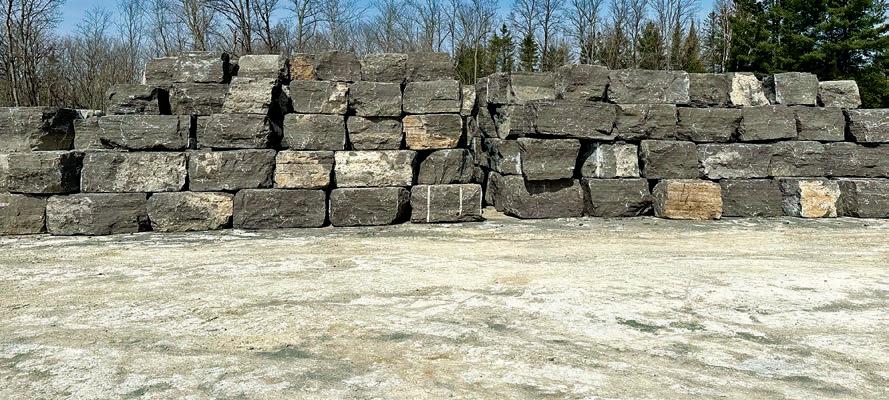

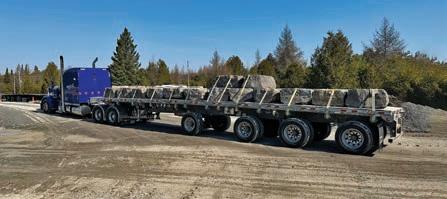


Platinum offers a variety of products including: Armour Stone, Flagstone, Weathered Cap Rock, Natural and Saw Cut Steps and Skidded Armour.
Platinum is open year round for all your Armour Stone needs. Rain, snow or shine!
